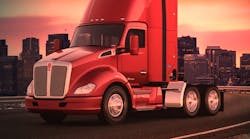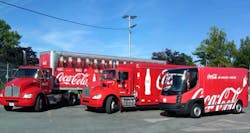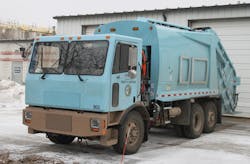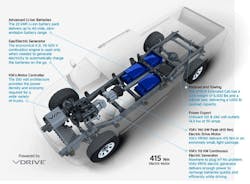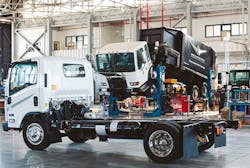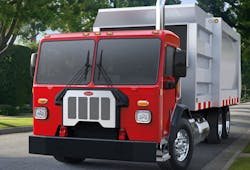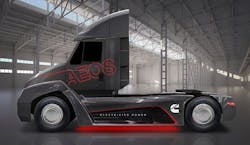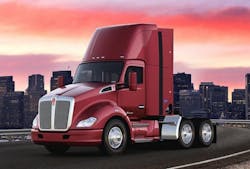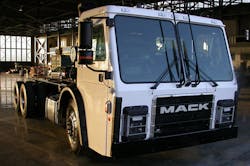Download this article in PDF format.
Without much fanfare, some of the world’s largest corporations have started to employ electric trucks. Companies that now count electric delivery trucks among their fleet include Coca Cola (Fig. 1), Frito Lay, and UPS in the U.S., and Heineken in the Netherlands. To pursue this emerging trend, major truck manufacturers are planning to produce new electric trucks. Plus, electric-vehicle (EV) pioneer, Tesla, will introduce its own electric truck in 2017.
1. Coca Cola uses electric trucks to deliver products.
The move to electric power has been on the rise. Every day, several million trucks shuttle among warehouses, distribution centers, retail stores, homes and offices, delivering everything from potato chips to cases of soda. Every night they’re back in the garage, and the next morning they’re charged up and ready to go. Their job is to move products using the lowest-operating-cost vehicle—the electric truck.
Electric trucks fit in a variety of jobs that depend on their gross vehicle weight rating (GVWR). The table lists these classifications for U.S. trucks. Electric trucks now go as high as Class 8.
The recently introduced eCanter, from Daimler’s Mitsubishi FUSO division, is said to be the world's first fully electric-powered light truck (Fig. 2). Lithium-ion battery packs power its 185-kW permanent magnet synchronous motor that provides 380 Nm of torque. Power is transferred to the rear axle by a standard single-speed transmission. Maximum speed is 55 mph, and it can carry a payload from 4,000 to 9,000 lbs., depending on the distance traveled and traffic conditions. It’s able to drive for 80 to 90 miles, road conditions withstanding, which is enough for city work.
2. Daimler’s Mitsubishi FUSO takes advantage of water-cooled lithium-ion batteries.
The vehicle’s present battery capacity is 70 kWh. Battery packs are spread over five units, one centrally in the frame right behind the cab and two more on each side of the frame. The upcoming small-scale production run calls for individual battery packs with three to six sets of 14-kWh batteries. This will allow the eCanter to be adapted to customer requirements in terms of range, price, and weight.
Batteries can be charged up to 80% capacity within an hour with dc at a quick charging station, or 100% in seven hours from the ac line. In the future, rapid charging with 170 kW will provide 80% battery capacity in only half an hour.
Motiv delivered its first all-electric refuse truck (ERV) (Fig. 3) in 2014 to the city of Chicago. The scalability and flexibility of the Motiv electric Powertrain Control System (ePCS) made it a good choice for an electric refuse truck.
3. The electric Powertrain Control System (ePCS) developed by Motiv powers a refuse truck in Chicago.
Chicago specified that the ERV must meet the demanding requirements placed on all of its garbage trucks. This included 60-mile range, nine tons of payload capacity, and 1000 pounds per cubic yard of compaction, enabling the ERV to operate anywhere in Chicago. Its 10 battery packs provide 200 kWh, which is enough to move the truck and power the hydraulics all day. Full charge time is eight hours using Motiv’s Universal Fast Charger.
Hydrogen-Electric Semi Truck
The Nikola Motor Company’s Nikola One is a Class 8 hydrogen-electric hybrid freight truck. This full-scale semi will offer a range between 800 and 1,200 miles, and produce 1,000 hp, about twice that of an average diesel truck. The company claims it will operate at half the cost of a comparable diesel truck.
Nikola One has a 320-kWh battery that supplies six traction motors with a combined software-limited 750 kW and 2,700 Nm of torque, after gearing. This is sufficient for a speed of 65 mph with a full load of 36 tons on a 6% grade.
The energy source is a 300-kW hydrogen fuel cell consuming 10-lb H2 per 62 miles from tanks with 220 lb of hydrogen, giving it a range of 1,200 miles. Consumption is equivalent to 15.4 mpg of diesel. The truck has regenerative brakes to supplement the traditional disc brakes, decreasing stopping distance and fuel usage. Unveiled in 2016, this truck is expected to be available by 2019. As an option, compressed natural gas can be used to power an on-board gas turbine generator to recharge the batteries.
Because a hydrogen fueling infrastructure is rare in the U. S., Nikola will produce and distribute its own hydrogen. The company intends to deploy 364 hydrogen stations across the U.S. and Canada, which CEO and founder Trevor Milton said will be completed within 10 years.
OEM-Built Electric Refuse Truck
BYD formally introduced its Class 8 battery-electric refuse truck, which is the first of these trucks designed and built by an original equipment manufacturer and is 100% battery electric. This truck employs the company’s proprietary iron-phosphate battery technology, enabling 92 miles of range. In addition, a proprietary Battery Management System assists with balancing and charging safety.
Its battery capacity of 188 kWh can be charged at an 80-kW rate using 480-V ac three-phase power. This refuse truck can charge at 40-, 80-, 100-, or 200-kW rates, requiring between one and five hours to charge depending on its power interface. The truck’s battery technology allows a projected 80% capacity after 5,000 cycles or 14 years, if charged every day.
Highly efficient, transversely mounted, ac permanent-magnet synchronous motors are integrated with the drive axle. Maximum power is 482 hp. Maximum torque is 2,212 lb-ft. Regenerative braking extends battery life and reduces brake component wear. A vehicle-to-grid (V2G) system allows the truck to deliver power back to the grid, a load, or another vehicle.
With a 10-ton payload, the truck provides 76 miles of range with minimal battery degradation. The truck’s cab and chassis platform includes batteries, high-voltage control system, all-electric propulsion system, and electric power takeoff for powering the hydraulic system to operate the refuse-truck bodies.
Operating costs are reduced due to high-efficiency electric motors and motor controls, lower maintenance on propulsion systems, fewer fluids to change, less brake wear due to regenerative braking, and fewer moving parts.
Retrofitting with Electricity
Via Motors expects to have its technology available to customers within two years. When ready, Via Motors will install its eREV powertrain in the GM Silverado truck or Express van (Fig. 4). These vehicles will be able to drive the first 40 miles in all-electric mode, and a full range of 400 miles on a single charge. It generates its own charging power using a fuel-efficient onboard generator or “range extender.” You can plug into a standard outlet or charge batteries in half the time with a 240-V outlet or charging station.
4. Via Motors’ eREV powertrain is intended for the GM’s Silverado truck and Express van.
The Wrightspeed Route is a plug-and-play hybrid repower kit for commercial trucks (Fig. 5). It is a high-power, medium-duty vehicle powertrain that uses electric drive with an onboard power station for efficiency and range. The kit includes controls, 200-kW inverter, electric motors, gear box with clutch-less shifting, battery pack, battery-management system, and LC user interface. It can be scaled up for heavier equipment, such as off-road construction vehicles, or down for medium-duty machines.
Wrightspeed’s CEO Ian Wright estimates that on average, an electric powertrain saves trash-truck operators $35,000 a year in reduced fuel and maintenance costs. The technology doesn’t require expensive exhaust treatment systems and, unlike diesel powertrains, doesn’t break down as often because it has fewer moving parts.
5. The Wrightspeed Route is a plug-and-play series hybrid repower kit intended for commercial trucks.
Wrightspeed’s Route is technically a plug-in hybrid system with a 60-kWh lithium-ion battery pack that powers its electric motor. The battery can be recharged through regenerative braking, as well as from an on-board generator driven by a micro-turbine.
This pint-sized turbine burns gasoline, diesel, or natural gas and propane to drive a generator to charge the batteries. Without the turbine assist, an electric truck would need $500,000 worth of batteries to achieve the same kind of range and occasionally have to drop out of service to recharge. The turbine generator system is lighter and more powerful than an equivalent internal combustion-engine generator system.
The Route relies on a four-speed electronic transmission without clutches and with fewer parts than a standard heavy-truck transmission. Regenerative braking slows the truck to almost a complete stop without tapping the mechanical brakes, which can save thousands of dollars a year in brake-replacement costs.
Converting a $500,000 California emissions-legal diesel trash truck into an electric vehicle—with the companion power electronics and computerized control system—costs about $150,000, Wright said, “but the payback is four to five years.”
Major Truck Manufacturers
Peterbilt displayed a Model 520 refuse truck demo with an advanced battery-electric drive system at WasteExpo 2017 (Fig. 6). The Peterbilt Model 520 is equipped with the Transpower ElecTruck drive system, which has accumulated over 80,000 miles of Class 8 heavy-duty use in a variety of commercial applications since 2013. The ElecTruck system employs high-power electric motors, inverters, and batteries to power commercial trucks weighing as much as 80,000 lb.
6. Peterbilt’s Model 520 refuse truck integrates an advanced battery-electric drive system.
The variant of the TransPower ElecTruck system developed for the Model 520 refuse truck uses a 300-kWh battery pack so that it can operate for up to 65 miles or eight hours on a single charge. The ElecTruck system also features a 70-kW onboard battery charger that can fully charge the truck’s lithium-ion battery pack in two to four hours.
Cummins unveiled a fully electric Class 7 concept truck called AEOS (Fig. 7). Its lighter, denser battery design allows it to hold a longer charge for improved range and faster charging, reducing down time. The 18,000-lb truck has a maximum payload capacity of 44,000 lbs. and a 100-mile range on a single charge, enabled by a surprisingly small 140-kWh battery pack.
7. The Cummins electric Class 7 concept truck, an 18,000-lb truck with a maximum payload capacity of 44,000 lbs, maintains a range of 100 miles on a single charge.
Cummins has an optional diesel range extender to add 200 miles of range for a total of 300 miles on a charge.
The vehicle is intended for urban freight routes, which could be feasible even with just the all-electric range. Cummins says that the vehicle can be fully charged in an hour, but it aims to reduce that by the time the vehicle is available, which hasn’t been set yet.
Kenworth announced that it is developing a prototype hydrogen fuel-cell version of its T680 day cab for drayage trucks (Fig. 8). Kenworth’s prototype is a Class 8 hydrogen fuel-cell truck that produces true zero emissions.
8. The Kenworth prototype T680 cab is a Class 8 hydrogen fuel cell-powered truck.
A hydrogen fuel cell from Ballard Power Systems will charge batteries on the truck. The T680 day-cab truck will use lithium-ion batteries to power a dual-rotor electric motor, driving the rear tandem axle through a four-speed automatic transmission. Kenworth’s hydrogen truck is expected to be ready for initial track and on-road testing by the end of 2017.
Each truck will have an electric-only range of about 30 miles, and the onboard fuel will provide sufficient range for a full day in regional haul applications, according to Kenworth.
Kenworth will build its first unit for this project in 2018. Kenworth engineers will be able to make design and system refinements to the 2018 unit based on data collected from this year’s real-world testing of the initial 2017 hybrid-electric T680.
Mack’s new garbage truck is based on its LR model, featuring a range-extended electric powertrain (Fig. 9). The system uses electric motors to drive the front wheels and allows the truck to benefit from more load-hauling low-end torque than conventional diesel engines. Motors are powered by batteries that can be recharged while the truck is operating via regenerative braking and through a turbine generator that can use natural gas or diesel fuel.
9. Mack’s new garbage truck features a range-extended electric powertrain from Wrightspeed.
The powertrain, developed by Wrightspeed, is designed to replace vehicle components like the truck’s diesel engine and transmission system with electric drive. The Wrightspeed powertrain can significantly reduce fuel consumption compared to conventional garbage trucks, delivery vehicles, and buses, according to Mack, a division of Volvo Trucks.
Range extenders help to increase the amount of time drivers can operate a vehicle on electricity alone. The on-board range extender uses a turbine generator to charge the battery as it drains so that drivers don’t have to stop and plug-in their vehicle. The range-extender generator can burn fuel, produce electricity, and keep the battery pack charged. The battery pack can also be charged from the utility grid.
Although Mack’s electric garbage truck made its first public appearance in 2017, there is no plan for commercial sales until Mack and Wrightspeed have finished their tests.
Refuse vehicles are a small, but important, segment of heavy-duty truck sales. They accounted for about 4% to 5% of the 242,000 Class 8 truck registrations in the U.S. last year, according to Mack's analysis of IHS Automotive data.
Monster Electric Vehicle
A Swiss consortium of companies is constructing the world’s largest electric vehicle. It will weigh 45 tons when empty and have 65 tons of loading capacity—and be powered by a 700-kWh-capacity battery pack (Fig. 10). That’s as much as eight Tesla Model S vehicles.
This monster electric vehicle is a retrofitted, used Komatsu dumper truck. The diesel engine has already been removed and space is being made around the chassis for the battery packs.
10. Powered by a 70-kWh battery pack, this retrofitted vehicle will weigh 45 tons when empty, and take on 65 tons of loading capacity.
The electrically powered Komatsu HD 605-7 is expected to transport material down from a mountain ridge and into the valley 20 times a day. Instead of heating up the brakes during the descent, the gigantic electric engine acts like a generator recharging the battery pack. The empty truck then uses this energy to travel back up the hill. If all goes as planned, the electric dumper truck will even harvest more electricity while traveling downhill than it needs for the ascent.
The battery pack for the e-dumper will weigh 4.5 tons and consist of 1,440 nickel-manganese-cobalt cells. Never before has a land vehicle been fitted with such a vast battery pack. These cells are also the choice of the German automobile industry when it comes to next-generation electric cars.
The vehicle will conquer slopes of up to 13% inclination under the harshest of environmental conditions while straining the batteries up to 3,000 A, but also charging them by 40 kWh during a single descent and traveling as an energy plus vehicle on balance (plus 10 kWh of energy per roundtrip).
Recharge Power
The world’s cargo fleet is moving from fossil fuels to electrons, but powering them won’t be simple. For example, driving a semi-truck 500 miles today would require a 23-ton lithium-ion battery, half the weight of the truck itself. Another possibility would be fuel cells, but they would require an expensive hydrogen fuel tank to go 500 miles. And, embedding wireless charging coils in roadbed would be expensive and inefficient.
However, an 1870 invention used to power trains and streetcars might be the answer: catenary, overhead electrical wires commonly found everywhere. Siemens proposes this approach, contending that it can power unlimited-distance electric trucks with intermittent overhead wires that provide enough energy for fast-moving, long-haul highway journeys.
With on-board batteries added to the trucks, Siemens estimates all of Germany’s roads could be outfitted for long-distance electric hauling with just 4,000 km of wire. Trucks would be able to recharge on highways and operate on battery power while on rural and urban streets. The system would cost a fraction the price of alternatives, and deliver as much $227 billion in net savings over 30 years.
